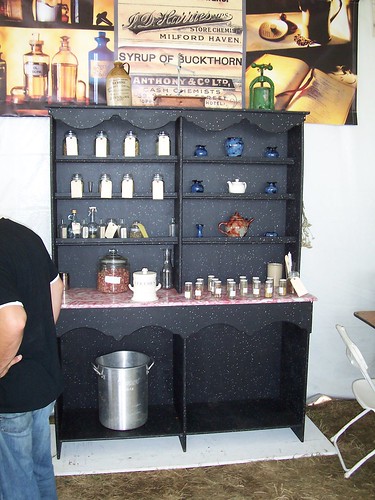JWS/caw
9 April 1962
Mr. W.O. Miller
Exhibit Manager
The Upjohn Company
Kalamazoo, Michigan
Dear Mr. Miller:
Last year the Medical Museum had approximately 700,000 visitors and it is anticipated that the figure will reach the million mark by 1963.
We would like to have the opportunity of exhibiting The Cell during 1963. Do you have a photograph and descriptive material on this exhibit?
It is regretted that The “Brain” is too complicated to exhibit here.
Sincerely yours,
John W. Sheridan
Colonel MSC
Curator, Medical Museum
An unofficial blog about the National Museum of Health and Medicine (nee the Army Medical Museum) in Silver Spring, MD. Visit for news about the museum, new projects, musing on the history of medicine and neat pictures.
Showing posts with label pharmaceuticals. Show all posts
Showing posts with label pharmaceuticals. Show all posts
Saturday, April 9, 2011
Saturday, April 17, 2010
Letter of the Day: April 17 - North Pole expedition
Curatorial Records: Numbered Correspondence 1418
1st Endorsement.
War Department,
Surgeon General’s Office
April 17, 1896.
Respectfully referred to Lieut. Col. D. L. Huntington, Deputy Surgeon General, U.S. Army, in charge of Museum and Library Division, for his action, in connection with previous papers in the case.
Geo. M. Sternberg
Surgeon General, U.S. Army
--
To the Minister of the United States of America
Mr. Thomas S. Ferguson
Dear Sir!
In answer to your request for the particulars of the medical equipment of the “Andrees Polarexpedition 1896” I respectfully beg to communicate to you the following:
In furnishing this medical outfit I had to consider two circumstances.
First, -the extent of the whole must be as limited as possible. Secondly, - the packing must [be] strong enough to stand jolting and water. For this purpose, I suppose it would have been most practical to have india-rubber vessels, but such articles are not manufactured in Sweden, and it would be very difficult to order them from abroad.
It was also requested that no object of metal should be used, Mr. Andree desiring to avoid metals wherever possible.
On this account no comparison can be made with the very nice medicine cases, (of American and English manufacture) provided for instance by Mssrs Burroughs Welcome & Co, London which are so highly approved by Stanley and Dr. Parker.
All the pharmaceutical preparations are with two or three exceptions in a dry form such as gelatin and tabloids.
For drawing up the schedule care has been taken to provide for the diseases occurring in earlier Swedish expeditions to Polar regions.
The medicines which are in small doses, are made up in gelatine, a form of medicinal preparations, invented many years ago by General direktor Almen, and is of a very practical nature, as a cover the size of a common envelope, can hold many hundreds doses. They are used in Sweden for such preparations as laudanum, morphia, and quinine, they are usually kept in their coatings, in this case, they have been put into glass tubes.
The rest of the medicines are in tabloids previously mentioned and which are also manufactures in Sweden.
Tabloids containing poisonous drugs are in addition enveloped in very thin paper to prevent them getting broken, it being impossible to use such tabloids unless they are in a perfectly whole collection.
The method for preserving and packing the medicine is as follows.
The gelatives and tabloids are put into tubes of thick glass, with corks especially cutted and prepared to resist damp and water. The labels are also prepared in a similar manner.
Each label is also supplied with a number – which is also given in the little book containing a list of the medicines, - and also the name of the expedition, the name of preparation and the dose to be taken, and finally the names of the diseases for which it is used, which are also given in the book above mentioned, in alphabetical order together with short advice given by the physician as to their treatment and the medicine to be employed.
Each of the glass tubes is fitted into a wooden case (turned?) lined inside with india rubber and cotton wool, a band of india rubber being fixed outside and finally the outside of the case is marked with the same numbers as the glass tube, and is burnt into the wood.
By this arrangement the most important medicines can be carried without further trouble as regards packing, in the event of a journey by sleigh, when everything in the way of baggage must be reduced to a minimum.
The whole collection is then packed in an air and water tight box of wood and india rubber, stamped on the outside with the name “Polarexpedition Andrees 1896,” the word “medicine” and the weight.
Respecting the above mentioned catalogue I herewith beg to enclose a leaf as a typical example of the whole.*
I am Sir yours very respectfully
C.F. Lundberg
Examined Apothecary
Hopapotcket Lejonet
Stockholm 31 Mar 1896
*Filed in a separate envelope
1st Endorsement.
War Department,
Surgeon General’s Office
April 17, 1896.
Respectfully referred to Lieut. Col. D. L. Huntington, Deputy Surgeon General, U.S. Army, in charge of Museum and Library Division, for his action, in connection with previous papers in the case.
Geo. M. Sternberg
Surgeon General, U.S. Army
--
To the Minister of the United States of America
Mr. Thomas S. Ferguson
Dear Sir!
In answer to your request for the particulars of the medical equipment of the “Andrees Polarexpedition 1896” I respectfully beg to communicate to you the following:
In furnishing this medical outfit I had to consider two circumstances.
First, -the extent of the whole must be as limited as possible. Secondly, - the packing must [be] strong enough to stand jolting and water. For this purpose, I suppose it would have been most practical to have india-rubber vessels, but such articles are not manufactured in Sweden, and it would be very difficult to order them from abroad.
It was also requested that no object of metal should be used, Mr. Andree desiring to avoid metals wherever possible.
On this account no comparison can be made with the very nice medicine cases, (of American and English manufacture) provided for instance by Mssrs Burroughs Welcome & Co, London which are so highly approved by Stanley and Dr. Parker.
All the pharmaceutical preparations are with two or three exceptions in a dry form such as gelatin and tabloids.
For drawing up the schedule care has been taken to provide for the diseases occurring in earlier Swedish expeditions to Polar regions.
The medicines which are in small doses, are made up in gelatine, a form of medicinal preparations, invented many years ago by General direktor Almen, and is of a very practical nature, as a cover the size of a common envelope, can hold many hundreds doses. They are used in Sweden for such preparations as laudanum, morphia, and quinine, they are usually kept in their coatings, in this case, they have been put into glass tubes.
The rest of the medicines are in tabloids previously mentioned and which are also manufactures in Sweden.
Tabloids containing poisonous drugs are in addition enveloped in very thin paper to prevent them getting broken, it being impossible to use such tabloids unless they are in a perfectly whole collection.
The method for preserving and packing the medicine is as follows.
The gelatives and tabloids are put into tubes of thick glass, with corks especially cutted and prepared to resist damp and water. The labels are also prepared in a similar manner.
Each label is also supplied with a number – which is also given in the little book containing a list of the medicines, - and also the name of the expedition, the name of preparation and the dose to be taken, and finally the names of the diseases for which it is used, which are also given in the book above mentioned, in alphabetical order together with short advice given by the physician as to their treatment and the medicine to be employed.
Each of the glass tubes is fitted into a wooden case (turned?) lined inside with india rubber and cotton wool, a band of india rubber being fixed outside and finally the outside of the case is marked with the same numbers as the glass tube, and is burnt into the wood.
By this arrangement the most important medicines can be carried without further trouble as regards packing, in the event of a journey by sleigh, when everything in the way of baggage must be reduced to a minimum.
The whole collection is then packed in an air and water tight box of wood and india rubber, stamped on the outside with the name “Polarexpedition Andrees 1896,” the word “medicine” and the weight.
Respecting the above mentioned catalogue I herewith beg to enclose a leaf as a typical example of the whole.*
I am Sir yours very respectfully
C.F. Lundberg
Examined Apothecary
Hopapotcket Lejonet
Stockholm 31 Mar 1896
*Filed in a separate envelope
Sunday, March 7, 2010
Accession of the day, March 7
We have been scanning our accession records, which makes browsing them a whole lot easier. This letter is dated November 14 but I'm taking liberties with the date as it was received at the Museum on March 7. I don't know if we still have this item; if so, I'd love to see it.
Dispensary received Mar. 7, 1901
Extract from Letter of Ludwig Rosenthal, filed in the Library Branch, Mus. & Lib. Division.
Munchen,
Hildegard - Strasse 16
Nov. 14, 1900.
To the Library of the Surgeon General's Office,
Washington, D.C.
I beg to report if not sold meanwhile:
Little house-dispensary with contents, XVI-XVIIth century. The little shrine, worked in black ebony is inlaid and ornamented with ivory and marble. Lock, angles, rings, etc. in gilt iron with artfully worked heads and foliage. The opened (lead) lid shows 15 divisions, in which are kept little glasses with brass clasps and two engraved little silver boxes. One division is empty; the narrow sides form pushers opening little drawers and secret panels, wherein are remnants of pills and three colored tablets with the impressed inscription "Terra Sigillata" 1851 and the monograms K. B with a crown. In another secret panel a tin box with old salve. At the lower part of the shrine are two drawers, where the instruments may have been kept.
This little shrine is artistically and carefully worked and well kept. H. 16.4 cm, L 27 cm depth 16.5 cm.
Price M. 250.
Dispensary received Mar. 7, 1901
Extract from Letter of Ludwig Rosenthal, filed in the Library Branch, Mus. & Lib. Division.
Munchen,
Hildegard - Strasse 16
Nov. 14, 1900.
To the Library of the Surgeon General's Office,
Washington, D.C.
I beg to report if not sold meanwhile:
Little house-dispensary with contents, XVI-XVIIth century. The little shrine, worked in black ebony is inlaid and ornamented with ivory and marble. Lock, angles, rings, etc. in gilt iron with artfully worked heads and foliage. The opened (lead) lid shows 15 divisions, in which are kept little glasses with brass clasps and two engraved little silver boxes. One division is empty; the narrow sides form pushers opening little drawers and secret panels, wherein are remnants of pills and three colored tablets with the impressed inscription "Terra Sigillata" 1851 and the monograms K. B with a crown. In another secret panel a tin box with old salve. At the lower part of the shrine are two drawers, where the instruments may have been kept.
This little shrine is artistically and carefully worked and well kept. H. 16.4 cm, L 27 cm depth 16.5 cm.
Price M. 250.
Friday, January 22, 2010
That Old-Time Gonorrhea Treatment
Those of you who follow our Flickr account know we have a special place in our hearts for STDs. Prophylactics, propaganda, you name it; if it has to do with a social disease, we do our best to publish it.
I went to a dusty, off-the-beaten-track museum in New Orleans last weekend - the New Orleans Pharmacy Museum. I have a lot of very neat stuff from there, but have to lead off with A Safe and Speedy Remedy for the Cure of Gonorrhea and Gleet. I have never heard of Gleet.

I went to a dusty, off-the-beaten-track museum in New Orleans last weekend - the New Orleans Pharmacy Museum. I have a lot of very neat stuff from there, but have to lead off with A Safe and Speedy Remedy for the Cure of Gonorrhea and Gleet. I have never heard of Gleet.

Thursday, October 15, 2009
Trade literature additions
A couple of weeks ago, I personally bought a few pieces of 1950s trade lit for the collection - these pharmaceutical ads are all blotters for fountain pens. They're filed under companies' names now. They're not exciting, but the price at the flea market was right, and now perhaps someone will use them. Blotters, Phedrol, Agarol, Alcaroid... all gone.

Blotter - Phedros eases spasmodic and irritating bronchial coughs due to colds.

Blotter - Agarol for Constipation, William E Warner & Co.

Blotter - Alcaroid, an effective alkalizer and digestant, American Ferment Company.
[American Ferment Company? An honest name at least.]

Blotter - Phedros eases spasmodic and irritating bronchial coughs due to colds.

Blotter - Agarol for Constipation, William E Warner & Co.

Blotter - Alcaroid, an effective alkalizer and digestant, American Ferment Company.
[American Ferment Company? An honest name at least.]
Sunday, June 28, 2009
Medical exhibit at Smithsonian Folklife Festival

The Smithsonian Folklife Festival is going on this week, and in the Wales section is a small exhibit on the history of medicine.

Wales turns out to be a major source for medicinal leeches, sold by Biopharma.
There is also a small display of historical pharmaceuticals.

Pill rollers aren't all that uncommon even now, but that's a nice ledger and some good ephemera in the labels.

The largest section was a medical garden.



The exhibit is up through July 5th
Sunday, January 4, 2009
Less pharmaceutical advertising fun
No Mug? Drug Makers Cut Out Goodies for Doctors
By NATASHA SINGER
New York Times December 31, 2008
The pharmaceutical industry has agreed to a voluntary moratorium on branded promotional items.
Well, darn. I like the geegaws, although I'm in a constant debate with historical collections over whether or not to keep them. I'm in favor since they are part of medical history of a type.
By NATASHA SINGER
New York Times December 31, 2008
The pharmaceutical industry has agreed to a voluntary moratorium on branded promotional items.
Well, darn. I like the geegaws, although I'm in a constant debate with historical collections over whether or not to keep them. I'm in favor since they are part of medical history of a type.
Friday, March 21, 2008
Pharmacology as a technology
Coincidentally the NY Times reported on the deaths of two men who developed drugs for treating mental states.
The articles are:"Frank Ayd, 87, Who Advanced Thorazine Use, Is Dead,", by DOUGLAS MARTIN, March 21, 2008.
Dr. Ayd studied his patients’ responses to early antipsychotic and antidepressant drugs, helping to give birth to the field of psychopharmacology.
and: "Frank Berger, 94, Miltown Creator, Dies," By BENEDICT CAREY, March 21, 2008.
Dr. Berger helped start the modern era of drug development with his invention of Miltown, the first mass-market psychiatric drug and a forerunner of Valium and Prozac.
These two obituaries show what a short time has passed since mind and mood altering drugs, besides alcohol, were developed and have become common, helping millions of people, but leading to many debates over the proper use of them. For thousands of years, medicine used some basic drugs and these didn't change much. In the 19th and 20th century, that was no longer true, and a new branch of the history of medicine opened up.
The articles are:"Frank Ayd, 87, Who Advanced Thorazine Use, Is Dead,", by DOUGLAS MARTIN, March 21, 2008.
Dr. Ayd studied his patients’ responses to early antipsychotic and antidepressant drugs, helping to give birth to the field of psychopharmacology.
and: "Frank Berger, 94, Miltown Creator, Dies," By BENEDICT CAREY, March 21, 2008.
Dr. Berger helped start the modern era of drug development with his invention of Miltown, the first mass-market psychiatric drug and a forerunner of Valium and Prozac.
These two obituaries show what a short time has passed since mind and mood altering drugs, besides alcohol, were developed and have become common, helping millions of people, but leading to many debates over the proper use of them. For thousands of years, medicine used some basic drugs and these didn't change much. In the 19th and 20th century, that was no longer true, and a new branch of the history of medicine opened up.
Thursday, February 28, 2008
How pharmaceuticals really are made
I'm sure most of us still hold to the old white-coated scientists in gleaming labs with ingredients never touched by human hands view. So read this fascinating expose.
Twists in Chain of Supplies for Blood Drug
By DAVID BARBOZA and WALT BOGDANICH
New York Times February 28, 2008
Differing statements from the factory owner and traders highlight the difficulty of tracing the supply chain in China for the blood-thinner heparin.
Chinese pig intestines!
Twists in Chain of Supplies for Blood Drug
By DAVID BARBOZA and WALT BOGDANICH
New York Times February 28, 2008
Differing statements from the factory owner and traders highlight the difficulty of tracing the supply chain in China for the blood-thinner heparin.
Chinese pig intestines!
Subscribe to:
Comments (Atom)